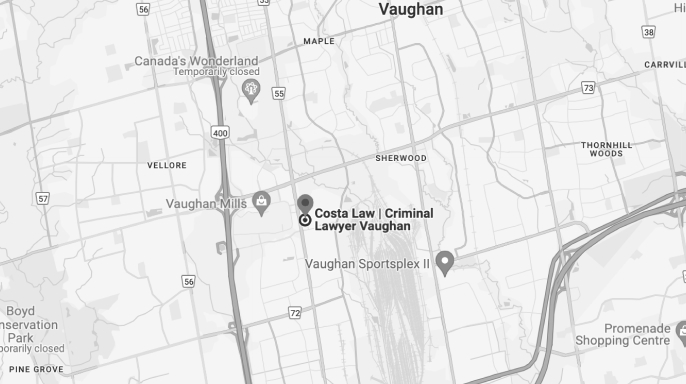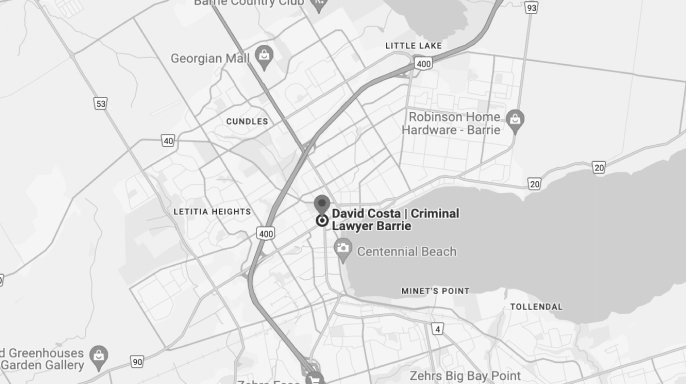What Is the Sentence for Criminal Negligence Causing Death?
In Canada, criminal negligence causing death is considered a serious criminal offence. It is a straight indictable offence that attracts a maximum punishment of life imprisonment. The lowest possible penalty for this criminal offence is a 4-year imprisonment term.
Penalties for criminal negligence causing bodily harm or death may also involve probation, and subsequent offences may carry harsh penalties. For example, if you are convicted of reckless driving causing death or bodily harm, you may be required to pay a fine of at least $2,000 but not over $50,000.
In addition, a two-year jail term or a maximum of 5-year license suspension, mandatory driver improvement training, and six demerit points are also relevant penalties. Being convicted of a crime related to criminal negligence causing bodily harm or death attracts severe penalties. Therefore, if you are facing charges or allegations of criminal negligence causing death, you should consult a knowledgeable lawyer who can defend you.
Criminal Code of Canada and Criminal Negligence
Canada’s Criminal Code outlines different negligence criminal offences, including failure to provide the necessities of life and dangerous driving. The criminal negligence offence is described in Section 219, while Section 220 outlines criminal negligence causing death.
According to Section 220, if you cause death to another person through criminal negligence, you may be guilty of an indictable offence. Upon conviction, you face a minimum punishment of imprisonment for 4 years if you used a firearm to commit the crime. The maximum punishment for this criminal offence is life imprisonment.
Criminal Negligence
Section 219 of Canada’s Criminal Code outlines criminal negligence as the foundation for Section 220 (which focuses on criminal negligence causing death). You may be criminally negligent if, by taking any action or failing to perform your duty, you show wanton or reckless disregard for another person’s safety or life.
For the Crown prosecution to get you convicted of criminal negligence causing death, the essential elements of this charge must be proven beyond reasonable doubt. These elements include:
1. The Guilty Act
The actus reus (the guilty act) for criminal negligence causing death should be established by proving the following aspects beyond a reasonable doubt.
- The alleged offender had a legal duty of care (duty imposed by the law)
- The offender acted or failed to act as per their legal responsibilities
- The defendant’s conduct of failing to meet his or her legal responsibility caused the death of another individual
The Crown prosecution must prove these three elements and establish that the accused’s act or omission was the direct cause of the victim’s death. Most legal duties are outlined under Section 215 of the Criminal Code. For instance, parents have the legal duty to ensure their children have the life necessities. Note that children under 16 cannot provide life necessities for themselves.
Legal Duty
Section 216 shows that medical and surgical treatment providers have a legal duty to possess skill, reasonable knowledge, and provide care to their patients. Section 217 requires that anyone undertaking an action has the legal duty to complete it if failure endangers someone’s life.
Finally, Section 217.1 imposes a legal duty on a person who undertakes or is in a position of authority to direct how another individual performs a specific task. The person in the position of authority must take reasonable steps to prevent injury or another form of harm from arising at the workplace.
Note that this is not an exhaustive list of the legal duties outlined in the Criminal Code. Therefore, you may have a legal duty that is not listed here.
Factual Causation and Legal Causation
For the Crown prosecution to prove that you (the accused) caused another person’s death, they must consider two elements of the alleged crime. First, factual causation answers the question, “Were it not for your actions or failure to act, would have the other person died?”
If the prosecutor cannot prove beyond reasonable doubt that your actions or failure to act was the direct cause of the other individual’s death, you cannot be convicted. Secondly, the prosecutor must prove legal causation.
This element focuses on whether your action was a significant contributor to the cause of the victim’s death. You cannot be convicted if the Crown cannot prove that your action was a significant contributing factor to the victim’s death.
2. Mens Rea or the Guilty Mind
For you to be convicted of criminal negligence causing death, the Crown prosecutor must prove beyond a reasonable doubt that your actions indicated a wanton or reckless disregard for other people’s safety or lives. In addition, it should be proven that your conduct revealed a ‘marked and substantial departure’ from the expected conduct or actions of a reasonably prudent person.
Assessing a “Wanton or Reckless Disregard”
The objective analysis of ‘wanton or reckless disregard’ for other people’s lives and safety is outlined under Section 219 of the Criminal Code. That means if a reasonable person would have predicted the risk of your conduct and taken reasonable steps to prevent bodily harm or death, then the ‘guilty mind’ or mens rea of your criminal negligence is met. This concept is known as the reasonable person standard.
According to the Supreme Court, the judge must assess whether your conduct shows a ‘marked and substantial departure’ from that of a prudent and reasonable person.
“Marked and Substantial Departure’
In any case involving criminal negligence causing death, the prosecutor must prove that the alleged offender’s conduct or actions showed a ‘marked and substantial departure’ from how a reasonable person would act under the same circumstances. Sure, there is no specific measure for the marked departure. However, the superior court has stated that it must have an elevated standard.
Note that the level of departure often varies with the criminal offence. For a case involving criminal negligence causing death, the significant departure must be of an elevated standard. Thus, the court must assess whether the offender’s conduct created risk for other persons.
In addition, the court will consider whether someone reasonable would have foreseen the safety risk and taken reasonable steps to successfully prevent bodily harm to the other persons.
Criminal Negligence and Homicide
According to Section 222 (1) of the Criminal Code, a person commits homicide when he or she causes the death of another human being. A homicide can be either culpable or non-culpable, and the latter is not considered a criminal offence.
Culpable Homicide
Section 222(1) of Canada’s Criminal Code shows that a person commits culpable homicide when they cause the death of another person through an unlawful action, criminal negligence, or by wilfully frightening the victim. It can also happen through the threat of violence, deception, or anything else that causes the victim’s death.
Note that for a person to be found guilty of culpable homicide, they must have caused the death of another human being. Therefore, a person who commits culpable homicide must have done more than just reason. Here are other important elements to consider in a culpable homicide case.
Killing a Child
In a case related to criminal negligence causing death, a child meets the ‘human being’ definition when it has proceeded from its mother’s body in a living state. That means a child is considered a human being whether or not the child has breathed, has independent circulation, or its navel sting has been severed completely.
With this definition in mind, a person commits culpable homicide when he or she injures the child before or during birth. Hence, the child died after legally becoming a human being.
Death could have Been Prevented
A person commits culpable homicide when his or her action or omission of an action leads to the death of another human being. This is particularly true if the human being could not have died had the offender resorted to proper conduct. That means the accused’s conduct departed from the standard conduct expected from a reasonable person.
Death Associated with Injury Treatment
Suppose someone causes another human being bodily harm that leads to death during surgical or medical treatment. In that case, the person commits culpable homicide through proper or improper treatment that was applied in good faith.
It is important to note that homicide cases are complex, and you need the legal counsel of an experienced lawyer if you are facing such negligence charges.
Criminal Negligence and Driving Offences
If the police file a criminal charge against you after an accident, it will be most likely for criminal negligence, careless driving, or dangerous driving. The latter involves operating a vehicle in a way that endangers other individuals and is a serious crime under Section 320.13 of the Criminal Code of Canada.
In the context of dangerous driving, criminal negligence occurs when the offender (possibly the driver) does something or fails to perform their legal duty. Remember, criminal negligence happens only if the driver’s conduct shows wanton and disregard for the safety and lives of other persons.
Punishment for Dangerous Driving Involving Criminal Negligence
You can be convicted of dangerous driving through indictment or summary conviction. Depending on the circumstances of your case, dangerous driving may be considered an indictable offence and liable to a maximum penalty of ten years imprisonment. If you are convicted on summary conviction, you could face an imprisonment term for up to 2 years less a day.
Dangerous driving that leads to bodily harm is an offence punishable by at least a fine of $1,000 (for the first offence), imprisonment for a term of at least 30 days, and imprisonment for a term of not less than 120 days (for each subsequent offence). Remember, the offender faces up to two years (less a day) in prison for a summary conviction and up to 14 years in prison if the prosecutor chooses to proceed by indictment.
Dangerous driving causing death is considered an indictable offence and liable to a maximum penalty of imprisonment for life if found guilty. Remember, a conviction related to criminal negligence causing death will also lead to the suspension of your driver’s license as per Ontario’s Highway Traffic Act. Furthermore, convictions for driving-related offences will stay on your driver’s record for at least ten years.
Reducing Criminal Charges to Traffic Offences
Sometimes, law enforcement officers may charge an alleged offender with criminal negligence or dangerous driving wrongly. Depending on the facts and circumstances of your case, an experienced criminal negligence lawyer can negotiate the withdrawal of your criminal charges for a plea to traffic offences like careless driving.
Penalties for Traffic Offences
Reducing criminal negligence charges to traffic charges can be helpful in a complex case where your careless driving caused the bodily or death of another person. Careless driving occurs when you fail to pay attention to other drivers and exercise reasonable care while driving. That means careless driving that causes bodily harm or death cannot be considered a criminal offence.
These are offences under Ontario’s Highway Traffic Act. If convicted, you face fines ranging from $400 to $2,000 or up to six months imprisonment. Other penalties include up to two years of license suspension and demerit points on your driver’s license. Thus, the penalties for careless driving (whether it causes bodily harm or death) are different from the punishments for dangerous driving or criminal negligence causing death or physical harm.
Difference Between Civil and Criminal Negligence
Civil negligence is simply a level of negligence that establishes liability. For instance, in a civil lawsuit arising from a motor vehicle crash, the element of negligence is proven based on a balance of probabilities.
On the other hand, the Crown prosecutor must prove criminal negligence beyond a reasonable doubt. This level of negligence occurs when you (the accused) recognize a risk and still wanton or reckless disregard for the safety and lives of other people.
Therefore, criminal negligence is linked to the element of blameworthiness. Remember, negligence causing death must be proven beyond reasonable doubt that the offender’s general conduct shows wanton or careless disregard for life.
The classification of your conduct (at the time of the unlawful act) as civil or criminal is a challenging area of criminal law. This is why it is recommended to have an experienced lawyer to defend your rights and ensure proper classification of your charges. In addition, a competent lawyer may negotiate to reduce your criminal negligence charges (in the context of driving) to traffic offences.
Penalties for Criminal Negligence Causing Death
The Criminal Code of Canada provides for a maximum punishment of up to life imprisonment for the criminal charge of negligence causing death. Consequently, the offender is not eligible for a sentencing that entails a conditional sentence order or discharge.
Criminal negligence causing death usually carries a mandatory minimum sentence that will lead to the offender’s incarceration. During sentencing, the court will pay attention to the offender’s mental health, intellectual function, and accountability. In addition, the court will consider the offender’s moral culpability, the intended consequences of the offender’s actions, and more.
CAUTIONARY WARNING: these writings are intended by Costa Law Firm Professional Corporation to serve strictly for promotional purposes and are not to be considered to be legal advice to the reader’s particular situation – ALWAYS actively consult directly and exchange particular information with a licensed lawyer or paralegal as appropriate in the circumstances.
David Costa
Dir.(416)788-6329





